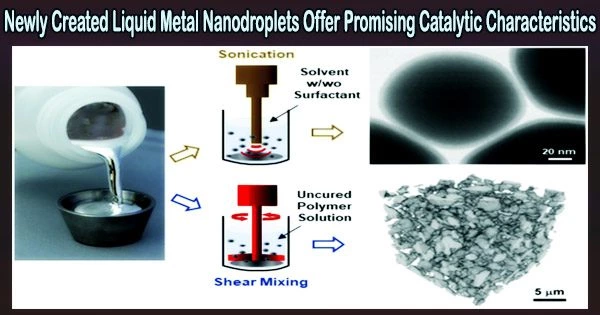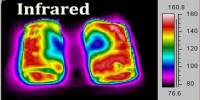A novel method created at RMIT University in Australia has been used to effectively create liquid metal nanodroplets that resemble planets. The nanodroplets have an exterior “crust,” a liquid metal “mantle,” and a solid “core,” just like our own planet Earth does.
By “locking up” the same quantity of solute (i.e., the “target” metals) in each alloyed droplet, the solid intermetallic core is the key to generating a more homogeneous mix.
Through total dissolving inside the liquid-metal media, made achievable by hot, molten salt, the study team was able to achieve homogeneity. Their article, “Synthesis of planet-like liquid metal nanodroplets with promising properties for catalysis,” was published in Advanced Functional Materials in July 2023.
The discovery opens up new avenues for research in basic liquid-metal chemistry and has applications in a wide range of fields, including fuel cells, catalysts, flexible electronics, and phase-change materials.
Liquid metal nanodroplets shake apart
In recent years, liquid metals have become a potential new area of chemical study, serving as an innovative reaction interface for catalysts and solvents.
Due to delocalized metallic connections and a soft, fluid core, they can also operate as a functional material with high conductivity.
Synthesis of liquid metal nanodroplets has gained importance due to the need for high surface areas in new catalysis, sensing, and nano-electronic applications.
There are many combinations possible when alloying for specific applications, for example dissolving copper (the solute) in liquid gallium (the metallic solvent).
By mechanically agitating a solvent like ethanol or water with sound waves, liquid-metal nanodroplets are produced.
However, during this “sonication” process, liquid-metal alloys have tended to “de-alloy,” i.e., to break apart into their constituent metals.
A key advantage of liquid-metal systems is the ability to adjust the metal mix for certain applications, dependent on the properties of the constituent metals. For example, copper is a great electrical conductor. When we combine copper with gallium, we not only save significant cost in material consumption, but also open the way to flexible electronics, such as what you might have seen in sci-fi movies.
Caiden Parker
This is a result of earlier processes trying to dissolve the metals at temperatures that were quite low, close to room temperature. “Just as it’s possible to dissolve more sugar in warm water than in cold water, more copper can be dissolved in warmer gallium,” says lead author Caiden Parker, a Ph.D. candidate at RMIT.
Before fully dissolving at low temperatures, some of the solute metal reforms into larger, solid particles.
The features of the final mixture are uneven and inhomogeneous, and the make-up of individual nanodroplets varies greatly. “In extreme cases, many or even most nanodroplets may be essentially devoid of the solute metal, which ends up being concentrated in only very few particles,” says corresponding author Dr. Torben Daeneke, also at RMIT.
For scientists trying to comprehend the basic processes at play in liquid metal chemistry, this inhomogeneity and the presence of intermetallic compounds present significant challenges.
High-temperatures and salts form homogenous, planet-like nanodroplets
In the new study, RMIT researchers resolved the problem of dealloying by significantly heating the synthesis process (as high as 400°C) to ensure the solute metal is completely dissolved and introducing a carefully selected molten-salt suspension fluid.
Because it is stable at high temperatures and is simple to remove afterwards, sodium acetate was chosen.
The resulting nanodroplets feature an interesting planet-like structure consisting of an outer (oxide) shell, a liquid (metal) mantle and a suspended, solid central core (intermetallic).
“We were immediately struck by the nanodroplets’ similarity to an Earth-like planet, with a solid outer shell, a liquid metal mantle, and a solid metal core,” says Caiden.
By “locking up” the same amount of solute in each alloyed droplet, that solid core is the secret to the new technique’s success.
“We were also delighted to see that our new metallic planet-like nanodroplets were everywhere,” continues Caiden.
The system was homogenously spread, with output yield significantly improved. Transmission Electron Microscope (TEM) analysis confirmed the core structure is observed in almost every droplet.
A very intriguing application for the planet-like nanodroplets in catalytic reactions which accelerate chemical reactions is made possible by the existence of the solid core.
The electrocatalytic oxidation of ethanol by the copper-gallium nanodroplets investigated showed encouraging results that might be used in ethanol fuel cells.
Prior to this catalytic process, it is crucial to remove the sodium acetate, which can be removed in straightforward water baths.
What’s next?
High-surface area nanodroplets might now potentially be used in a variety of future applications, including but not limited to electronics or catalytic materials, thanks to the promising new approach.
Fundamental studies of liquid-metal chemistry will also benefit from the physical scale of the nanodroplets (i.e., nano rather than micro), which will help with investigations into the specifics of bond formation within liquid metals, solvation capabilities, crystallization dynamics, and the general colloidal chemistry that may occur within various molten metal systems.
“The planet-like structures are like little miniature laboratories, allowing us to study how molten metals behave at an atomic level,” says Torben.
While the study demonstrated the new method’s viability using a copper-gallium system, the authors anticipate additional research to demonstrate the method’s viability in other solute and solvent alloy systems, starting with silver, zinc, or bismuth in liquid gallium, tin, or indium.
“A key advantage of liquid-metal systems is the ability to adjust the metal mix for certain applications, dependent on the properties of the constituent metals,” says Caiden. “For example, copper is a great electrical conductor. When we combine copper with gallium, we not only save significant cost in material consumption, but also open the way to flexible electronics, such as what you might have seen in sci-fi movies.”
With the possible use of copper-based nanodroplets in heat dissipation systems, copper may potentially be used for its thermal qualities.
In the latest study, copper-based nanodroplet catalysis applications have previously been tested, with improved active-site area in addition to cost-effective material manufacturing.
Regarding a different metal, silver has already been used in applications because to its anti-microbial qualities; when mixed with gallium, it might produce a more bioavailable substitute.
“Thus the potential applications of the new technology are extremely wide. Any industries in need of nanomaterials can utilize the system, with constituent metals varying according to application,” says Torben.
















